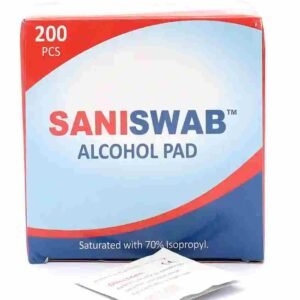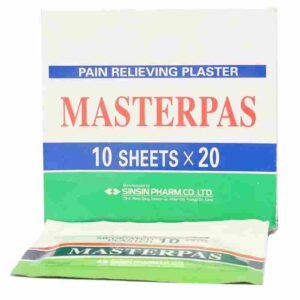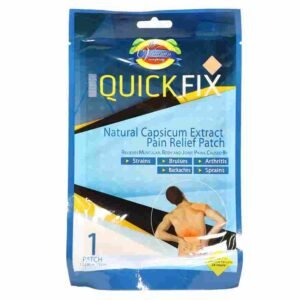Description
Welcome to the future of home healthcare with our Mercury-Free Clinical Thermometer Mercury. This professional-grade instrument is designed for precise body temperature measurement, providing families with a safe, reliable, and environmentally conscious alternative to older mercury-based devices. Accurate fever detection is a cornerstone of home health monitoring, and this thermometer delivers clinical accuracy right in your home.
This advanced thermometer is engineered for everyday use, offering peace of mind for parents, caregivers, and individuals managing their wellness. By eliminating the risks associated with mercury, you are choosing a safer home environment and a healthier planet. Its robust design and user-friendly features make it an indispensable tool in any modern medicine cabinet.
Here is a brief summary of what makes this thermometer an essential health device:
-
Accurate Fahrenheit and Celsius Scale: Precisely monitor temperature fluctuations with a clear, dual-scale reading.
-
Non-Toxic Gallinstan Alloy: A safe, advanced liquid metal alternative to hazardous mercury.
-
Shatter-Resistant Construction: Durable build designed to withstand the rigors of home use.
-
Easy-to-Read Liquid Crystal Display: A bright, clear scale ensures quick and error-free temperature reading.
-
Rapid Response Time: Get a accurate reading quickly, which is crucial when monitoring a fever.
What Are the Primary Uses and Key Features of a Thermometer Mercury?
Understanding the capabilities of this device is key to utilizing it effectively for family health. This section details its core functions and the engineering that makes it a superior choice.
Common Uses for a Mercury-Free Thermometer
This versatile tool is designed for a variety of health monitoring scenarios. Its primary use is for checking body temperature to detect fever, a common symptom of infection or illness. It is ideal for oral temperature taking in adults and children, axillary (underarm) use for all ages, and rectal temperature measurement for infants, which is considered the gold standard for accuracy in babies. Beyond body temperature, it can also be used to measure the temperature of bath water for infants, ensuring it is safe and comfortable, and for checking room temperature in environments where climate control is critical for patient care.
Key Features and Engineering Benefits
The thermometer incorporates several design innovations that enhance its functionality, safety, and accuracy.
-
Advanced Gallium-Indium-Tin (Galinstan) Core: This non-toxic, liquid metal alloy expands uniformly with temperature changes, providing the same reliable performance as mercury without any of the associated environmental or health hazards. It is a precisely calibrated filling material for clinical-grade accuracy.
-
Triple-Scale Precision Measurement: The high-visibility stem features clear markings for both Fahrenheit and Celsius, allowing for flexible use according to personal or regional preferences. This dual-scale clinical thermometer ensures you can interpret results based on your needs.
-
Shatter-Resistant, Medical-Grade Glass: The outer casing is manufactured from a durable, borosilicate glass that is designed to resist breaking if dropped accidentally. This safety feature is crucial for use around children and the elderly.
-
Magnified Cylindrical Lens for Clarity: The stem is engineered with a lens effect that magnifies the liquid column and scale markings, making it exceptionally easy to read the temperature, even in low-light conditions or for those with visual impairments.
-
Parallax-Free Temperature Reading Strip: Special markings ensure that when you look directly at the thermometer, you get an accurate reading without the distortion caused by viewing from an angle, a common issue with cheaper models.
What is Inside a Thermometer Mercury? A Look at Ingredients and Composition
While not “ingredients” in the traditional sense, the internal components of this thermometer are critical to its function and safety. Understanding what it is made of builds trust and clarifies its advantages.
Detailed Component Breakdown
The main functional component is the thermometric liquid inside the capillary tube. Our thermometer uses a patented Galinstan alloy, which is a blend of Gallium, Indium, and Tin. This metallic mixture remains liquid at a wide range of temperatures and provides a consistent, linear expansion for highly accurate readings. Unlike mercury, Galinstan is non-toxic and poses no risk of poisoning if the thermometer were to break.
The glass body is made from lead-free, medical-grade borosilicate glass, known for its high resistance to thermal shock and chemical corrosion. The scale is printed with a non-fading, FDA-approved ink that is baked onto the glass for permanent legibility. A blue dye is added to the Galinstan alloy to enhance the visibility of the liquid column against the white background of the scale.
Benefits of the Key Components
The use of Galinstan is the cornerstone of this product’s safety profile. This liquid metal filler is entirely biodegradable and safe for disposal. Borosilicate glass ensures the device can be sterilized with alcohol wipes without clouding or degrading, maintaining hygiene between uses. The combination of these high-quality materials results in a durable, long-lasting, and safe family health tool that outperforms plastic digital alternatives in terms of stability and not requiring batteries.
How Do You Correctly Use a Clinical Glass Thermometer?
Proper technique is essential for obtaining an accurate body temperature reading. Incorrect usage can lead to false readings, which may impact health decisions.
Step-by-Step Guide for Accurate Temperature Taking
For Oral Use (Adults and Cooperative Children Over 4):
-
Ensure the thermometer is clean and has been shaken down to read below 96°F (35.5°C).
-
Place the silver tip (the bulb) under the tongue, either to the left or right of the frenulum.
-
Instruct the person to close their lips gently but firmly around the thermometer and to breathe through their nose.
-
Leave the thermometer in place for a minimum of 3 minutes, or as recommended by the manufacturer. Avoid talking or moving during this time.
For Rectal Use (Infants and Young Children):
-
Shake the thermometer down and lubricate the silver bulb with a water-soluble jelly.
-
Place the infant on their stomach across your lap or on a firm surface.
-
Gently insert the bulb only about half an inch to one inch into the rectum. Never force it.
-
Hold the thermometer in place, keeping a hand on the child’s buttocks for at least 2 minutes to prevent movement and potential breakage.
For Axillary (Underarm) Use:
-
Shake the thermometer down and ensure the armpit is dry.
-
Place the bulb in the center of the armpit, ensuring skin-to-glass contact.
-
Have the person hold their arm down snugly against their body, crossing their arm over their chest.
-
Leave the thermometer in place for a minimum of 5-7 minutes to get a stable reading.
Is There a Recommended Dosage for Thermometer Use?
The concept of “dosage” does not apply to a thermometer as it is a measurement device, not a consumable. However, there are clear guidelines on frequency of use and interpretation of results.
Guidelines for Frequency and Interpretation
For monitoring a fever, temperature can be taken every 4 to 6 hours to track the progression of an illness. It is not necessary or recommended to take a temperature constantly. The normal body temperature range is approximately 97.8°F to 99.1°F (36.5°C to 37.3°C). A fever is typically defined as a rectal or oral temperature reading at or above 100.4°F (38.0°C). Always follow the advice of a healthcare professional regarding when and how often to check a temperature, especially in infants under three months old.
What Precautions Should You Take When Using a Glass Thermometer?
Safety is paramount when using any medical device, especially one made of glass. Adhering to these precautions will ensure safe and effective use.
Essential Safety Warnings and Precautions
-
Never Use a Damaged Thermometer: Inspect the thermometer before each use. If you see any cracks, chips, or the liquid column is separated, discontinue use immediately.
-
Supervise Children Closely: A glass thermometer should always be used with direct adult supervision. Do not allow a child to walk or run with the thermometer in their mouth.
-
Avoid Biting or Chewing: Instruct the user not to bite down on the glass stem.
-
Rectal Use Caution: Be extremely gentle during rectal insertion. Stop if you meet any resistance. This method should ideally be used after demonstration by a healthcare provider.
-
Post-Use Hygiene: Clean the thermometer thoroughly with cool water and soap or an alcohol swab after each use to prevent cross-contamination.
-
Not for Stirring: The thermometer is a precision instrument and should never be used for any purpose other than measuring temperature.
Are There Any Side Effects of Using a Mercury-Free Thermometer?
When used correctly according to the directions, this thermometer presents no inherent side effects. It is a passive measurement tool. The only risks are those associated with improper use, such as the potential for minor injury from glass breakage or, in the case of rectal use, mucosal irritation if not performed gently. These are not side effects of the device itself but of the technique. The Galinstan alloy is non-toxic and poses no risk of poisoning, unlike mercury thermometers.
How Should I Store My Thermometer to Ensure Its Longevity?
Proper storage protects your investment and ensures the device remains accurate and ready for use.
Optimal Storage Conditions
Always store the thermometer in its protective plastic case. This prevents it from rolling off surfaces and getting damaged. Store the case in a dry place at room temperature, away from direct sunlight. Avoid storing it in humid areas like a bathroom cabinet without proper ventilation, as moisture can degrade the scale markings over time. Keep it out of reach of young children. Do not store it near heat sources like radiators or in freezing conditions, as extreme temperatures can affect its calibration.
Who Manufacturers This High-Quality Health Device?
This Thermometer Mercury Free 1S is manufactured under strict quality control protocols by a facility certified for Good Manufacturing Practices (GMP). Our manufacturer is a leading global supplier of medical diagnostic equipment, specializing in personal health monitoring devices. They hold relevant ISO certifications for medical devices and are committed to producing safe, reliable, and affordable healthcare products for the home. Their dedication to research and development ensures that every thermometer meets rigorous standards for accuracy and safety before it reaches the consumer.
What Are the Comprehensive Benefits of Switching to a Mercury-Free Thermometer?
Choosing this modern thermometer offers a multitude of advantages for your health, your family’s safety, and the environment.
-
Enhanced Household Safety: Eliminates the risk of mercury exposure and poisoning, which can cause severe neurological damage, especially in children. This makes it the safest choice for family health monitoring.
-
Environmental Responsibility: Mercury is a persistent and toxic environmental pollutant. By using a mercury-free alternative, you are preventing a hazardous substance from entering landfills and water systems, contributing to a greener planet.
-
Clinical-Grade Accuracy and Reliability: Provides precise temperature readings that you can trust for making informed health decisions. Unlike some digital thermometers, it does not rely on batteries and will always be functional.
-
Durability and Long-Term Value: Constructed from high-quality materials, this is a one-time purchase that can last for years with proper care, offering superior value over disposable or cheaply made digital models.
-
Ease of Use and Readability: The magnified lens and clear scale make it simple for anyone to read the temperature accurately without confusion over digital displays or error codes.
-
Universal Application: Suitable for oral, rectal, and axillary use, making it a versatile tool for every member of the family, from newborns to adults.
How Does a Mercury-Free Thermometer Compare to Other Types?
This comparison table highlights the key differences between common thermometer technologies to help you make an informed decision.
| Feature | Mercury-Free Glass Thermometer | Digital Thermometer | Mercury Thermometer (Legacy) | Infrared (No-Contact) Thermometer |
|---|---|---|---|---|
| Accuracy | High (Clinical Grade) | Variable (Medium to High) | High (Clinical Grade) | Lower (Surface Temperature) |
| Safety | High (Non-Toxic Alloy) | High | Low (Toxic Mercury Hazard) | High |
| Ease of Reading | Requires Reading Scale | Easy Digital Display | Requires Reading Scale | Easy Digital Display |
| Response Time | 3-5 Minutes | 30-60 Seconds | 3-5 Minutes | 1-3 Seconds |
| Batteries Required | No | Yes | No | Yes |
| Durability | High (Shatter-Resistant Glass) | Medium (Electronics Can Fail) | Low (Toxic if Broken) | Medium (Sensitive Optics) |
| Cost Over Time | Low (One-Time Purchase) | Medium (Battery Replacement) | N/A (Not Recommended) | High (Initial Cost, Battery) |
| Best Use Case | Reliable, at-home core temperature checks | Quick, general home checks | Should not be used | Quick screening, sleeping children |
Frequently Asked Questions About Mercury-Free Thermometers
How do I reset or shake down a mercury-free thermometer?
To reset the thermometer, hold it firmly at the end opposite the bulb. With a swift, snapping motion of your wrist, flick it downward several times until the liquid column reads below 96°F (35.5°C). Do this over a soft surface like a bed or carpet to cushion a potential slip.
Is the blue liquid inside the thermo meter safe?
Yes, the blue liquid is completely safe. It is the non-toxic Galinstan alloy, colored blue for better visibility. It poses no health risk if the thermometer breaks, unlike toxic mercury.
Why is my glass thermo meter reading differently than my digital one?
Small variations are normal. Ensure you are using the correct technique (e.g., oral vs. rectal) and allowing enough time for an accurate reading. Glass thermometers are often more consistent over time, while digital ones can drift or be affected by low battery. The glass thermometer is generally considered the more reliable standard.
Can I use this thermo meter to take my pet’s temperature?
Yes, but with extreme caution. Rectal use is the only method for pets and should be done gently and with assistance to restrain the animal. A dedicated pet thermometer is often a safer choice.
How do I properly clean and disinfect my thermometer?
After use, wash it with cool water and mild soap. Do not use hot water as it can break the column. Then, wipe the stem thoroughly with a cotton ball or pad soaked in 70% isopropyl alcohol. Let it air dry before storing it in its case.
What is the lifespan of a glass thermometer?
With proper care and storage, a high-quality glass thermometer can remain accurate for many years, even decades. Its lifespan is essentially indefinite unless it is physically damaged.
Is this thermometer safe for use during pregnancy?
Yes, it is perfectly safe. The non-toxic materials pose no risk to the mother or the fetus. It is an excellent tool for monitoring health during pregnancy.

 Cart is empty
Cart is empty 




Reviews
There are no reviews yet.